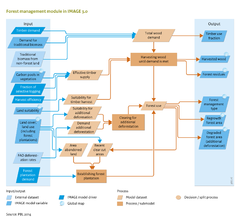Forest management: Difference between revisions
Jump to navigation
Jump to search
No edit summary |
m (Text replace - "ExternalModel=" to "Model-Database=") |
||
| Line 2: | Line 2: | ||
|Application=Rethinking Biodiversity Strategies (2010) project; | |Application=Rethinking Biodiversity Strategies (2010) project; | ||
|IMAGEComponent=Drivers; Land-use allocation; Carbon cycle and natural vegetation; Energy supply and demand; | |IMAGEComponent=Drivers; Land-use allocation; Carbon cycle and natural vegetation; Energy supply and demand; | ||
| | |Model-Database=EFIGTM model; | ||
|KeyReference=Arets et al., 2011; | |KeyReference=Arets et al., 2011; | ||
|Reference=FAO, 2010; Carle and Holmgren, 2008; Putz et al., 2012; FAO, 2006b; Alkemade et al., 2009; Hartman et al., 2010 | |Reference=FAO, 2010; Carle and Holmgren, 2008; Putz et al., 2012; FAO, 2006b; Alkemade et al., 2009; Hartman et al., 2010 | ||
Revision as of 09:54, 24 May 2014
Parts of Forest management
| Component is implemented in: |
| Components: |
| Related IMAGE components |
| Projects/Applications |
| Key publications |
| References |
Key policy issues
- How can management influence forest capacity to meet future demand for wood and other ecosystem services?
- What are the implications of forest management for pristine and managed forest areas, and on biomass and carbon stocks and fluxes of relevance for climate policy?
- What are the prospects for more sustainable forest management and the role of production in dedicated forest plantations?
